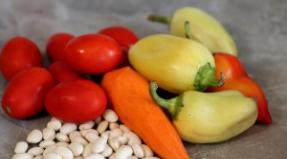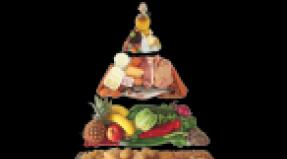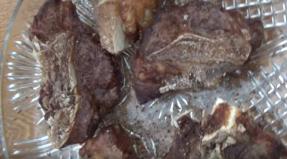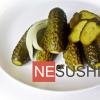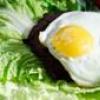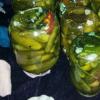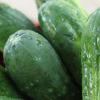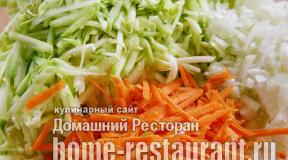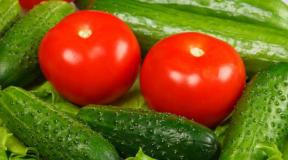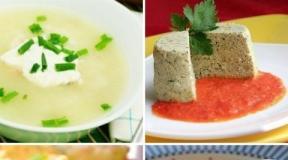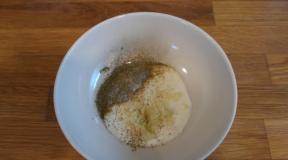Bread from wheat flour. Wheat bread
The main raw material for making bread is flour. For baking bread, various types of flour - wheat flour, rye, corn, barley, oatmeal and buckwheat. Almost every kind of flour can be used to make bread individually. A combination of different types of flour is also widely used to produce bread with new taste qualities.  Most often for making bread and bakery products use wheat and rye flour of various varieties. Other types of flour are used less frequently. Mainly for the preparation of national types of bread or as an additive to dough from wheat flour.
Most often for making bread and bakery products use wheat and rye flour of various varieties. Other types of flour are used less frequently. Mainly for the preparation of national types of bread or as an additive to dough from wheat flour.
Flour is industrially produced by grinding the original grain on a metal roll. At the same time, the grain is divided into its components - the shell (bran, rich in vitamins B1, B2, PP and E), the germ (the center of mineral substances, oils and proteins) and the endosperm, containing starchy substances and important for baking proteins, which form an elastic gluten and thus responsible for the quality of the dough and future products. When the dough is moistened and kneaded, the gluten forms a spatial grid that traps the gas bubbles emitted by the yeast (other biological agents, or obtained by adding soda and other disintegrating agents), which gives the finished product lightness and tenderness.
What flour is used in baking
Flour is divided into different varieties depending on the size of the particles (flour small and rough grinding) and the degree of purification from the membranes and the embryo (for wheat - extra, higher flour, I-th, II varieties and wallpaper; for rye - seeded, peeling and wallpaper). Wallpaper flour is obtained by grinding the grain without dividing it into components and its composition is almost similar to the grain from which it is made. In the past, it was the flour made from flour by grinding the flour on the millstones. The rye wallpaper flour crushed more finely and containing smaller amount of bran belongs to the grade "peeled". Wheat flour of the highest and first grade and rye seeded flour practically does not contain bran and germ. From flour of a fine grinding of higher grades more magnificent products turn out. Finely ground flour interacts better with water, and bran, weighting the dough and therefore preventing it from a good rise, are absent. Lower grades of wheat and rye flour contain larger particles. Flour from wheat of a rough grinding, kruplochka, consists of quite large parts. Such flour is not mixed with unleavened yeast dough, which, if kneaded with flour, doesn’t work well and the products turn out to be dense and quickly harden.
For making bread is most suitable white wheat flour (the highest and first grade), obtained from durum wheat. What are its advantages? Durum wheat is preferred because it is richer in gluten. Flour of these varieties is finely ground flour, it contains almost no bran and germ, rich in gluten. Such flour absorbs more moisture - the products do not stale longer, the dough rises well and forms a soft crumb with a uniform porosity. It is believed that wheat bread is more delicious. White wheat flour from firm grades and is called "baking". Products from wholemeal flour (gray wheat flour of the II grade), containing a certain amount of bran, have a nutty flavor, they contain vitamins, minerals, fats, and fiber, which is so necessary for the body. But such products are more dense and not so tender and tasty. Products made from wallpaper flour have a light brown color and are even richer in nutrients.

Products from rye flour They have a special taste and are very dense, as the resinous substances contained in the flour interfere with the formation of gluten. Rye flour is light or seeded (consists mainly of endosperm) and dark. Dark flour on the content of bran and germ is divided into peeled (flour with a lower content) and wallpaper (with a large). To give rye products pomp, add wheat flour to the dough. Adding a small amount of rye flour to the wheat dough will give baking a more interesting flavor.
Despite the fact that barley the flour consists mainly of endosperm, it is depleted in gluten and the barley bread comes out flat, dense and quickly stale. But a small amount of barley flour gives wheat bread an unusual pleasant taste. Sweet taste corn Flour is made by grinding dried grains and does not contain gluten-forming proteins. To make the corn bread pomp and softness, loosening is used with the help of chemical leavening agents or by adding hard whipped proteins. To loosen the dough with yeast, you need to add a large amount of wheat flour. Oatmeal Flour also does not form gluten and is mainly used as an additive to bread dough, which gives the product a new taste and makes it more crispy. Buckwheat Flour is also widely used in combination with wheat flour.
How to store flour?
Wheat flour (white) and rye (seed), not containing the germ, can be stored for up to a year in a dark ventilated cool place. Flour lower grades contain fat, which eventually rancid. Such flour is stored in the same conditions for 2-3 months. Do not keep the flour open when cooking, it is saturated with moisture, loses its properties and bugs can easily start in it.
Bread wheat - the most popular bakery product, considered the main product on each table. Differs in a balanced vitamin-mineral composition, excellent taste. The story of the appearance of bread goes back to the Neolithic era. In its original form, it resembled baked mush, made from water and cereals. The descendants of such bread are made all over the world to this day. These include Indian chapata, Chinese baobin, Mexican tortilla, North American corn and Scottish oatmeal.
It is believed that the first bread-based, appeared in Egypt, where local conditions favored active growth. For fermentation test (in quality) used bacteria present in the air.
“Bread is the head of everything” - young people from the older generation often hear it. Being the basis of nutrition for different nations, it is considered a source of life and a symbol of labor. In Christianity, bread is used in the sacrament of Holy Communion.
Advantages and disadvantages
According to statistics, during his life a person eats more than 15 tons of bread. Which product to prefer: white or black?
From the point of view of dietetics, bread causes not a bright opinion among gastroenterologists. To improve the taste and appearance, manufacturers often replace useful dietary fiber products with less coarse fiber, which not only does not provide any value to the human body, but can also cause harm. At the same time, the use of thermophilic yeast leads to dangerous consequences: a decrease in the level of calcium in the bones, the development of osteoporosis, the formation of gallstones, impaired blood flow, liver function, and the formation of a tumor.
White bread is a high-calorie product made from refined top grade, which contains many simple carbohydrates. Promotes weight gain.
People with diabetes need to remember that wheat bread has a high glycemic index - 95. After it is consumed, the blood level rises instantly, the body switches to emergency insulin. At the same time, the process of splitting saturated fats first slows down, then stops completely.
Wheat baked goods are easier to digest by the human body, and the mineral compounds they contain are absorbed faster than pastry made on a base. However, they are composed of substances that contribute to fermentation. Low fiber content adversely affects the intestinal function, which causes the formation of malignant tumors.
 Interestingly, stale bread is more easily absorbed by the human body than fresh pastries, which contain starch, which is a paste. He, in turn, irritates the walls of the digestive tract. Rusks can injure the mucous membrane of the stomach, so they are not recommended for people with gastritis and ulcers, food poisoning, flatulence, after a complex surgical operation during the rehabilitation period.
Interestingly, stale bread is more easily absorbed by the human body than fresh pastries, which contain starch, which is a paste. He, in turn, irritates the walls of the digestive tract. Rusks can injure the mucous membrane of the stomach, so they are not recommended for people with gastritis and ulcers, food poisoning, flatulence, after a complex surgical operation during the rehabilitation period.
The advantage of rye product is a rich chemical composition. Black bread - source, E, fiber, lactic acid bacteria, iron, zinc, magnesium. It is digested longer than white, contains elements that inhibit the absorption of protein, calcium.
Scientists believe that flavored pastry based on wheat flour increases the risk of developing problems with the gastrointestinal tract, endocrine and cardiovascular systems. At the same time, white bread energizes, and black - promotes weight loss.
Production technology
Depending on the type of raw materials used, wheat bread is made from flour of the first (1st grade), second (2nd grade) or top grade (w / c). The production technology involves the preliminary cleaning of grains from the shell containing the bulk of the nutrients - vitamins, trace elements, fiber. This impoverishes the final product. The higher the grade of flour, the less nutrients it contains.
White bread is produced in two types - hearth and tin. Their baking technologies do not practically differ from each other, while the form is not used to prepare the first one.
Stages of bread production
Preparation of dough with subsequent kneading dough. First of all, make a yeast and flour sourdough. The introduction of dough is a classic method for improving the quality of bread. The more flour will absorb liquids, the more gently the baking will turn out and the longer it will retain its freshness.
 Cooking and adding dough to the dough is a long and costly process that significantly increases the production cycle. At the same time at the exit the natural product turns out. Production of dough carry closed way. The process is fully automated, lasts at least 14 hours.
Cooking and adding dough to the dough is a long and costly process that significantly increases the production cycle. At the same time at the exit the natural product turns out. Production of dough carry closed way. The process is fully automated, lasts at least 14 hours.
The finished brew is poured into a mobile bowl - a bowl, where additional ingredients are introduced. Then it rolls under the kneading machine. Proper processing of the components determines the appearance of the bread after baking.
To reduce labor costs and production costs, chemical additives, improvers, are introduced into the dough. For example, to reduce the time spent on the preparation of dough, substances that absorb water faster than flour are added to the composition of the raw material. Bread prepared according to this technology is soft, fluffy, but it hardens very quickly and loses its taste.
Ready dough ripens at low temperature for 14-28 hours. During this period, it undergoes a natural fermentation process, enriched with taste and smell.
Dividing, molding dough. The bakery uses three lines of work with raw materials: Japanese machine, rounding divider, baguette.
The first allows you to work with the batter, with a moisture content of up to 85%, the second, on the contrary, with a dense. And the third performs division operations.
To obtain pieces of exact mass on the divider, set the desired values. The device weighs preparations on electronic scales. At the same time, it is important to take into account that in the baking process, part of the water evaporates, therefore, the weight of the blanks should be 10% more than the finished product.
Interestingly, the length of the baguette blank is checked manually with a tape measure.
After dividing, leave the dough to rest, otherwise the crumb will turn out "glued together." Due to the high humidity and yeast growth, the billet is saturated with moisture inside the proofing.
Before baking, the dough is spread on a baking sheet or planter, be sure to grease with a mixture of water, flour, starch or make cuts. Otherwise, the workpiece may lose its shape, become covered with bubbles.
Baking. The form with the dough is put in the oven, where it is blown with hot air. The finished bread is taken out with the help of a wide shovel, sent for packing, where the remnants of flour are removed from it, placed in boxes. Baking in any case can not be sealed in a plastic bag, otherwise the crumb will become flabby, and the crust - soft. As a result, he will "suffocate."
 Bread prepared according to the classic recipe with the introduction of sponge without adding improvers will never become moldy.
Bread prepared according to the classic recipe with the introduction of sponge without adding improvers will never become moldy.
Chemical composition
Wheat bread is one of the most consumed foods in the world. Good taste, the smell of fresh pastries excite the appetite, promote the processes of digestion. Bread starch is partially gelatinized, partly acquired soluble state, proteins are in denatured form, fats are emulsions. Thanks to the developed porosity and soft consistency, the availability of baking for the work of digestive juices increases.
The energy value of bakery products depends on the type of flour used. The lower it is, the less starch in it, more nutrients. Conversely, premium flour is almost completely devoid of valuable nutrients.
In bread, carbohydrates always prevail (50%). They satisfy the body's need for energy.
| Name | Nutrient content per 100 grams of product, milligrams | ||||
|---|---|---|---|---|---|
| Bread from flour / s | Bread from flour 1 grade | Bread from flour 2 varieties | |||
| Vitamins | |||||
| 37,8 | 54,0 | 61,0 | |||
| 1,0 | 1,2 | 2,3 | |||
| 0,9 | 1,6 | 3,1 | |||
| 0,18 | 0,29 | 0,46 | |||
| 0,12 | 0,17 | 0,23 | |||
| 0,1 | 0,13 | 0,29 | |||
| 0,03 | 0,06 | 0,08 | |||
| 0,0225 | 0,027 | 0,029 | |||
| 0,00124 | 0,0017 | 0,00215 | |||
| Beta Carotene (A) | – | – | 0,005 | ||
| 824 | 837 | 639 | |||
| 499 | 378 | 374 | |||
| 93 | 133 | 185 | |||
| 65 | 87 | 136 | |||
| 54 | 59 | 69 | |||
| 20 | 23 | 28 | |||
| 14 | 33 | 54 | |||
| 2,9 | 2,2 | 2,2 | |||
| 0,0032 | 0,0032 | 0,0032 | |||
| 1,1 | 2,1 | 3,6 | |||
| 0,526 | 0,735 | 1,353 | |||
| 0,45 | 0,825 | 1,088 | |||
| 0,08 | 0,134 | 0,215 | |||
| 0,066 | 0,066 | 0,066 | |||
| 0,048 | 0,048 | 0,048 | |||
| 0,0145 | 0,0145 | 0,0145 | |||
| 0,0106 | 0,0128 | 0,016 | |||
| 0,006 | 0,006 | 0,006 | |||
| 0,0016 | 0,0022 | 0,0033 | |||
| 0,0014 | 0,0019 | 0,0025 | |||
 Thus, baking made from flour of the 2nd grade provides the greatest value for the human body. Despite the rich chemical composition, heat treatment leads to a loss of 70% of the components. As a result, the body comes mainly starch, contributing to weight gain.
Thus, baking made from flour of the 2nd grade provides the greatest value for the human body. Despite the rich chemical composition, heat treatment leads to a loss of 70% of the components. As a result, the body comes mainly starch, contributing to weight gain.
In the gastrointestinal tract bakery products break down into sugars, therefore, the consumption of white pastries should be limited to diabetics. In addition, excessive craving for baking causes diseases of the endocrine system, destruction of the intestinal microflora, obesity.
Interestingly, in a day, people eat 9 million units of bread around the world.
How to cook at home
For high-quality baking, it is important to use fresh, dry flour without lumps. If it is damp, it needs to be dried. To determine the suitability of flour, a pinch of the product is moistened with water, look at the color. If it is light, then it is fresh, darkened - stale.
A prerequisite for obtaining airy, soft baking is sifting flour, which contributes to its enrichment with oxygen.
Recipe for making wheat bread with Provencal herbs
Ingredients:
- fresh yeast - 15 g;
- wheat flour grade 2 - 400 g;
Ready bread has a golden crisp, a porous crumb. Herb pastries are best eaten with salt and.
Conclusion
Wheat is the most popular cereal culture, well absorbed by the human body. On its basis, white bread is prepared, which has a greater nutritional value (235 kcal per 100 g) than (190 kcal per 100 g). Characteristics of baking wheat flour are high porosity (\u003e 50%), low humidity (45%) and acidity (4.2 degrees). The shelf life of the product - 24 hours.
Wheat bread made from coarse sorts of flour is more useful than higher quality because it contains more vitamins and fiber, which improves intestinal motility. Sometimes allergies can appear on white pastries. This is a normal reaction of the body to high protein in the product and yeast. In this case, it is necessary to limit the intake of the allergen, consult a doctor.
In order for the bread to turn out lush and fragrant, in no case should the dough be allowed to cool. Otherwise, it will get too thick texture, will be poorly digested.
Opara is considered ready for further use after it is covered with bubbles and will increase in volume by 2 times.
Properly mixed, rested dough does not stick to hands.
Willingness of bread is determined with the help of a wooden toothpick or sound. In the first case, it is thrust into the pulp, then gently reach. If it comes out with traces of dough - the product is baked, dry and clean - taken out of the oven. In the second case, they knock on the lower crust of the loaf. A distinct sound indicates the bread is ready.
In order to avoid obtaining a rubbery crust and sticky crumb, freshly baked pastries are cooled only in a natural way, providing air flow to its lower part.
Wheat products are perhaps one of the most beloved and popular types of baking in our country. Both young and old respect bread and bread, drink tea with bagels and muffins, treat guests with cakes and donuts.
Today, the range of products made on the basis of wheat flour is so huge that even to list it will be difficult. Just go to the appropriate department of any hypermarket and you will inhale an unimaginable scent. There and baguettes, and donuts, and cakes, and with a variety of fillings.
But how much do we know about wheat flour and wheat, in general, besides what we were taught in childhood? That bread needs to be cherished, one cannot play with it, that it is hard to get ... That "he has a head for everything."
Time, of course, has changed and today the stages of production of this main product in our life have become noticeably less labor-intensive, some have disappeared altogether. But this did not make him worse. Or, nevertheless, became? Today we will talk a little on this topic.
Today, in any store on the shelves in larger quantities you will see exactly white wheat bread, because it is more in demand, and just tastier. And, it is considered more useful. Is it so?
Of course, those loaves that our grandmothers baked were notable for their special beauty, flavor, and purity of the recipe. As a rule, they contained nothing but flour, water, and salt.
Before the yeast, homemade sourdough was used. Such baking simply did not need improvers and stabilizers, as it was eaten quickly. Today, manufacturers have to go for different tricks to each bun waited for its buyer, without losing in quality and taste.

Today, manufacturers add flavor enhancers and food additives, flavors, and sometimes dyes to the classic composition. But this does not change its basic composition, which includes many useful vitamins.
These components are: mono- and disaccharides, organic acids, saturated fatty acids, water, and ash.
A simple white bun contains fiber, vitamins of group B, E, H, PP, as well as copper, sodium, potassium, calcium, phosphorus, magnesium, copper, zinc, vanadium, chromium, silicon, iodine, magnesium, sulfur, boron, fluorine, molybdenum, selenium, zinc, iron, chlorine and cobalt, which in a small amount are very useful for the body.
If we consider the product in the ratio of proteins, fats and carbohydrates, then the lion's share will receive, of course, carbohydrates, their percentage is 83.6, respectively, 13.8% of proteins, and the least amount of fat, a little less than 3%.
Nutritional value and calorie
Calorie white loaf is 235 kcal. To understand how much it is, you can compare: for an hour of fast walking, a person with a weight of 79 kg spends 309 kcal. 100 grams of cucumbers contain 15 kcal, apples - 44 kcal, 100 grams of 20% cream - 213 kcal.
Its energy value in the ratio of proteins, fats and carbohydrates is 7.9 g (~ 32 kcal), 1 g (~ 9 kcal) and 48.3 g (~ 193 kcal). Energy ratio (b | W | y): 13% | 4% | 82%.

- For white bread made from high-grade flour - 266 kcal and BJU value: 7.64%, 3.29%, 50.61%
- Whole wheat loaf - 259 kcal (9.13; 4.11; 47.14)
- Ciabatta - 262 kcal (7.7; 3.8; 47.8)
- Low-calorie wheat loaf - 207 kcal (8.7; 2.5; 34.6)
- Wheat toasts - 313 kcal (12.96; 4.27; 51.07)
- Wheat flour loaf with bran addition - 248 kcal (8.8; 3.4, 43.8)
- Hearth loaf made of flour of the second grade - 228 kcal (8.6; 1.3; 45.2)
- Cutted long loaf from flour of 1st grade - 259 kcal (7.7; 3; 50.1)
These are just some types of product with the calculation of kcal per 100 grams and the ratio of BLC. A more accurate value of each product name can be calculated using a calculator, which can now be found on various sites without any difficulties.
Useful properties and harm
As we said above, white bread contains a number of vitamins useful for the body. That is, eating a slice of bread and butter at breakfast, we do ourselves a favor. But in a barrel of honey there is always a fly in the ointment, and there it is here too. In addition to all the listed benefits and benefits of this product can harm.
Than? Its amount. Large amounts of calories and starch are overweight and plaque in the vessels. In addition, overeating white loaves and rolls can lead to intestinal problems and diseases of the endocrine system. And if you abuse the baking with sugar - you can "eat" yourself not only overweight, but also diabetes.
It is believed that eating a small amount of fresh bread every day reduces blood cholesterol levels, strengthens the cardiovascular system, and helps to cope with depression.
For a healthy person, you can not be afraid and eat your favorite product up to 400 grams per day. The fiber contained in it favorably affects all digestive processes. However, if there are problems with excess weight, then the amount of consumption must be reduced, at least twice.
Sometimes, many go on a diet and completely deny themselves the pleasure to eat products made from wheat flour. Thus, they deny themselves and in the use of useful nutrients. In this case, a complete failure, most likely, to anything. You can simply revise the mechanism of consumption. For example, eat wheat product only in the morning, or replace it with a less high-calorie, for example, rye.

However, for people with high acidity, this option is not suitable. For them it is better to eat wheat bread, and even that, in small quantities.
The conclusion from the above is as follows: a measure is needed in everything. Love buns - eat on health, but alternate them with coarse-ground products. Do you like white baguettes? Great, but do not forget about rye and black loaves, they are also delicious! And no less useful, by the way!
Varieties of wheat bread
Types of wheat products are divided very simply - by type of flour. That is, the product can be higher, first or second grade. There is a third variety, the so-called wallpaper or wholemeal flour.
The highest quality product is made from the corresponding flour, therefore it turns out gently white and very soft, since it is extracted from the very kernel of the grain and goes through more than one processing stage. It is this bread that is most of all “deposited in the sides,” since it absolutely has no coarse fibers and fiber in the composition.

The lower the grade, the more bran flour and the rougher the baking.
Wallpaper flour, as a rule, is used for diet baking or so-called "fitness baking". It is so called because it contains more than any other variety of vitamins and microelements, and its high fiber content also makes it useful for the intestines, and therefore for the organism as a whole.
Strange, but true: in stores it is much easier to buy wheat flour of the highest and first grade, rather than wholemeal flour or even rye. Probably because baking turns out very tasty!
Wheat baking recipe according to GOST
According to the GOST recipe, the loaf can be prepared using the accelerated method using whey, reducing the two-stage fermentation process to a single-stage process, thereby reducing the preparation from 8 hours to 3.5.

The bottom line is that part of the water in this recipe is replaced by whey. Its acidity gives the first impetus for the fermentation of dough. This recipe, by the way, can be used for both first-rate and second-grade flour. The output will be a loaf weighing 1 kg.
Ingredients:
- Serum 140 ml
- Warm water 280 ml
- Flour 700 gr
- Live yeast 17.5 grams
- Salt 9 gr
Cooking:
1. First of all we mix water and serum. Note that you can play with the amount of both. The more will be the last, the more acidic the finished product will be. To obtain the desired humidity of 60%, the main thing is that the total volume of the liquid is 420 ml. This is 700 grams of flour.
To get a not very fresh loaf enough for 100 grams of flour to take 20 ml of whey and 40 ml of water. Since the flour we use today is set in the recipe, the serum will need 140 ml and 280 ml of water.
2. We mix yeast into our whey water, mix it thoroughly and add salt. The resulting mixture is poured into the flour and mix with a special spatula for kneading dough.

3. The humidity of such a test should be 60%. That is, this means that 60% of the liquid is taken per 100 g of flour. And the general temperature of liquids is about 30 degrees. This is a very convenient ratio for kneading dough with your hands, so when it reaches a suitable consistency, you can switch to manual kneading. The result should be a good soft dough with gluten.
If the dough sticks to the hands or to the work surface, flour cannot be added, brush your hands, or the table with vegetable oil.
4. After the dough becomes the desired consistency, it must also be mashed in the hands, stretching and forming a kind of ball. It should not break or break. To achieve such a state, it should be kneaded for about 10 minutes. Or even slightly more, look at its condition.

5. Ready dough to put in a bowl, cover with a towel and send in a warm place for proving. The temperature of a warm place should be 29-30 degrees. For this great cooling oven, or a stove above the included oven.

6. The dough should approximately double. After that, he again need to knead, stretch and fold the ends in the center. All these procedures are carried out on the working surface of the table.
This stage of the test with a very good effect on the final version.
The baton turns out magnificent and porous.

During this time, the gluten of the dough will weaken slightly and it will be possible to proceed to the formation of a loaf.

8. We spread our ball on the working surface. And roll out to the shape of a rectangle. After rolling the dough becomes very supple and elastic.

9. We twist our future loaf into a roll, properly pinching each turn of the rectangle.

Well pinch the last turn, so that the dough does not spread when baking. We also pinch the edges and push the “tucks” slightly inward, and roll a bit so that everything is fixed.

To do this, sometimes folded towels are put under the paper. Thus, our product is obtained as if a support on the sides, or it is also called "cradle".
If the dough is rather soft, such a cradle will not allow it to creep away. But today it is quite elastic and we do not use this moment.

11. Cover the dough with a towel or cling film and ship for 45 minutes at a temperature of 32 degrees.

12. We warm the oven to 250 degrees and place the container with water at its very bottom, since the loaf should be baked with steam.
13. Remove the towel from the pan, sprinkle the blank with water from a spray bottle so that the top does not burst during baking and make 5-7 oblique cuts with a knife.
14. We send the baking sheet into the oven, after abundantly sprinkling it and the contents on it with water. There he will stay 10 minutes at a temperature of 250 degrees.
15. Then remove the container with water, rearrange the baking tray to a lower level, and bake for another half hour at a temperature of 200-215 degrees.
16. While our loaf is baked, we will prepare a starch mixture for lubrication. To do this, mix a spoonful of starch with a glass of cold water and put on the fire until completely dissolved and thickened.

17. Take out the loaf, he browned, but as you can see, has a matte appearance without gloss.

Therefore, immediately in a hot condition, we lubricate it with a starch mixture and leave it for about an hour and a half to cool completely. A beautiful glossy fragrant loaf will be the decoration and the main treat on any table!

It is difficult to resist and wait until it is completely cooled. He just wants to break his hands as quickly as possible, and, burning, to eat a hot edge.
Recipe for wheat sliced \u200b\u200bloaf of high-grade flour
GOST is the recipe approved by the authorities, but there can be a great many recipes for a favorite product. You yourself can even become the author of your bun!

Therefore, later we will tell you how to make white bread from high-grade flour, lush and soft as a puff. Not according to GOST, but simply, from the heart! By the way, the more you add sugar to this dough, the sweeter and more enjoyable your product will turn out!
We have already baked several loaves, and today a new recipe.
Ingredients:
- Flour 3 cups (cup volume 220 ml)
- Water 1 cup (volume of glass 220 ml)
- Vegetable oil 6 tbsp
- Sugar 2 tablespoons
- Salt 1 tsp
- Yeast 2 tsp. (dry)
Cooking:
1. Pour the flour into a deep bowl. It must be sieved to oxygenate. For measure use a glass of 220 ml. They will measure.
If the glass has a volume of 250 ml, you can use it. And in this case, we also need to add exactly the same glass of water.

Add salt, sugar and yeast to flour and mix thoroughly.

2. In the dry mass make a dimple in the center and pour one glass of warm boiled water there. Water should be just warm, not more than 36 - 38 degrees. If it is hot, then the yeast will not be able to exist in it, they will simply die there.
As a result, the dough will not rise, and the loaves will be hard.

The dough will be quite thick, and knead it will take from 15 to 20 minutes. If there is not so much time for mixing, then add another 50 ml of water; kneading will be a little easier and faster.
3. Immediately add vegetable oil. Make sure it is odorless. Very tasty is obtained if you add olive oil, or 50% sunflower and 50% olive.

4. We start kneading with a spoon, gradually connecting the liquid part with the flowable one.
5. After kneading it with a spoon, it will become difficult to lay out the dough on the work surface and continue kneading there.

As already said above, knead the dough should be from 15 to 20 minutes, that is, until the state until it becomes smooth and uniform. To determine this will be quite easy. From lumpy and uneven, it should be soft, uniform, without any hint of lumps.
If your hands get tired, you can give them a break for 1 - 2 minutes. Or at this time the dough can be lightly thrown onto the working surface of the table from a small height. Thus, as if "beating off" him.
6. Brush with a bowl of vegetable oil and put the dough into it. Put it in a warm place and leave to infuse for about 1 hour.

6. After the dough has approximately doubled, we divide the ball into three pieces, that is, we will have 3 loaves in total.

On the cut it is clear that the dough has a large number of holes. This means that it is “alive” and will rise perfectly during baking.

7. We knead each piece in our hands and roll it out with a rolling pin to form a rectangle, then we roll it up. We pinch the edges to make a neat, shaped long loaf - blank.

8. We lay out our blanks on a baking sheet, covered with parchment paper or greased with vegetable oil. We make cross serifs so that the loaves bake well and do not crack when enlarged. Use a sharp knife for this.
And to make it even easier, you can sprinkle the surface of the loaf with water from a spray bottle.

9. Put the products in the oven, heated to 200 degrees for 20-30 minutes. It is advisable to put a bowl of water in the bottom of the oven. Forming steam will contribute to the appearance of a beautiful ruddy not hard crust.
Keep the bowl for 10 minutes, then remove and continue to bake the remaining time without it.

After the loaves are baked, you can grease the top with warm water so that the crust is not very hard. And also give them the opportunity to cool under a towel.
To eat with pleasure!
Making bread from flour 1 grade
If you are a flour lover of the first grade (and this is also possible!) And prefer less processed flour, then the following recipe is for you!
Ingredients:
- Flour of the first grade 500 gr
- Warm water 380 gr
- Dry yeast 2 tsp
- Salt 1 h
- Olive oil 2 tsp
Cooking:
1. In the warm water, add all the dry ingredients - salt and yeast, pour in the same vegetable oil and mix thoroughly.
2. Pour the mixture into the pre-sifted flour and knead the dough.

First, mix with a spoon, as soon as it becomes difficult, go to the manual batch.

3. Cover the bowl with the dough with a towel and leave in a warm place for about an hour. During this time, it should rise about twice.

4. After an hour, we can see that the mass has increased in volume quite well.

Lubricate the baking dish with vegetable oil. We also process our hands with them so that they will not stick to the dough when we remove it from the bowl. We don’t do anything else with dough and put it in a form, cover it with a towel. At this time, preheat the oven to 180 degrees.

The dough will stand for 15-20 minutes, take up all the free space in the form and rise slightly again.

5. Before being sent to the oven, grease our future loaf with an egg or vegetable oil and make several cuts. This is done to make it easier for him to climb.

6. Send our loaf in the oven for about 40 minutes, until golden brown crust is formed. After cooking, allow to cool for about 10-15 minutes.

This recipe will be loved by those who want to bake a delicious fragrant loaf, without spending a lot of time. You will be pleased with the result!
The use of sourdough for making bread
As we said above, not everyone likes baking with yeast, as if consumed excessively they can harm the body. In this case, leavening bread comes to the rescue!

We have already told in one of the previous articles. And today we will share with you the recipe for delicious lush wheat bread on sourdough.
Ingredients for cooking brew:
- Wheat starter 2 tbsp
- Water 200 ml
- Wheat flour 200g
For the test:
- Flour 1 grade 800 gr
- Water at room temperature 500g
- Salt 1 tbsp
- Sugar 1 tablespoon
- Vegetable oil 2 tbsp
- Prepared Opara
1. Our ferment must be prepared in advance by mixing the starter, flour and water. It should ripen for about 12 hours at room temperature. Then it will turn into a great brew, which is used instead of yeast.

2. Place the brew in a deep bowl, pour warm water. You can mix the mass manually. and if there is, then you can use the kneading machine.

Then pour sugar, salt and flour and knead the dough.

In the middle of the kneading add vegetable oil and knead until all the oil is absorbed.

3. The dough is quite soft and sticky, no need to be scared and add flour. Cover the bowl with a towel and leave for about 30 minutes.

4. Rested dough will be a little thicker.

We spread it on the working surface, generously sprinkled with flour and begin to knead it. This should be done as long as it does not become tender, soft and not sticky to the hands.

5. We divide the dough into two equal parts so that we have two loaves at the output.

6. We bake baking molds with vegetable oil, put our blanks there and leave for proofing for about 2-2.5 hours.

7. After the future bread rises, we send the molds into a cold oven and turn it on, setting the temperature to 180 degrees for about an hour.

8. After the oven, the ruddy crust can be greased with butter or sprinkled with water to make it softer. Then let cool by covering the products with a towel.

Needless to say that the finished product turns out very tasty! So bake it necessarily and please your loved ones.
What kinds of bread are there?
Almost all nations of the world have a respectful attitude towards this product. And it is believed that his baking must be approached with a good attitude, that the dough is able to convey all emotions.
Probably it is, because in different countries you can see with what love it is baked. And everywhere a gentle and beautiful name was invented for him.
- Slavic peoples and of course in Russia from time immemorial prepared loaves. Its peculiarity is that it is always round and is baked from high-grade flour. Festive options are decorated with cut out of the dough flowers, leaves. or animal figures. Sometimes getting real masterpieces.

- Famous and tasty ciabatta belongs to the people of Italy. Prepared on sourdough, or yeast from the flour of the highest grade, mainly with the addition of olive oil.
- French baguette - national pastries of France. Always happy with its crispy crust and soft crumb inside. The product has an elongated, rather thin shape.

- Turkish long loaf - delicious in its category in the East, served for breakfast, lunch and dinner.
- Tiger bread baked in the Netherlands. From above it is smeared with specially prepared rice paste, due to which a distinctive recognizable pattern is obtained on the finished product.

- From choux pastry on the American continent baked bagel. For this purpose, only flour of the highest grade is used. And to taste such a product vaguely resembles the taste of a donut.
- Three-hole pretzel based on malt, yeast and wheat flour baked in Germany. And he is called pretzel.

- In many countries of the East, various flat cakes are baked from wheat flour, and they have different names. In the Caucasus, it is pita, in Armenia - matnakash. And in the Middle East they bake pitta. In Italy, a similar cake has a name focacciawhich can be very thin and thick. And it can be baked from unleavened, or yeast dough.
- In India, the cake has a name naan, and in Israel - matzo.

- By the way, in Catalonia, in Spain they bake the most delicious payesIt can be completely round or it can have a definite shape, but it always has a golden color and a crisp on the cut.
- Daleba baked in China, and it is a kind of Russian loaf. Representatives of the Russian diaspora started baking it in Harbin. and now it can be found in the whole of China.
- And in Australia they bake dumper, the dough is prepared for it without yeast and proofing. It is an ascetic product on soda and flour of the first or second grade. And his homeland is supposedly Ireland.

Friends, I think that this list can be continued almost indefinitely. In any country where wheat is grown, there is bread. It can be prepared according to different technologies, as well as have different nutritional value, but everywhere it is honored and is always at the head of the table.
The world's best bakers cherish old national traditions, pass on pastry secrets from generation to generation, and bake ciabatta, baguettes, loaves, loaves ... all over the world.
And we have the opportunity to enjoy the fruits of civilization and bake bread and bread in our kitchen. Fortunately, now all the secrets are revealed and you can bake almost any pastry from any country in the world. The main thing is to have this desire and, of course, mood.
What I sincerely wish you. Bake delicious breads. And let you be delicious!
Enjoy your meal!
Wheat bread - very tasty and nourishing bakery product, which is daily found in the diet of almost every person. For many centuries, this pastry has been one of the main products on the table.
Classic wheat bread, as a rule, has a round or square shape, a crispy light brown surface and a soft white crumb (see photo). According to a standardized recipe, this product should consist of such ingredients.:
- wheat flour;
- yeast;
- purified water;
- salt.
Also in the composition of such a product may include milk, granulated sugar and various spicy spices.
Today, there are many factories engaged in the production of wheat bread. On an industrial scale it is made, according to the technological map, which consists of several stages. First prepare the flour. It must be sieved and, if necessary, mixed with other varieties. Then add the remaining ingredients to the mixture and knead the dough, following the technology. Having achieved the elasticity of the mass, it is divided into portioned parts, of which the grain blanks are subsequently formed. After this, the products are baked, cooled, packaged in bags, and also necessarily labeled and sent to the points of sale.
Types of wheat bread
Depending on the type of flour used, wheat bread is divided into the following types:
- top grade - bakery product, for the preparation of which flour is of the highest grade, such product is primarily characterized by the highest quality, as well as excellent taste;
- first varieties - a product made from flour of the first grade; according to its taste characteristics, such pastries are inferior to the previous bread variety;
- second varieties - this type of bread is made from low-grade flour (second grade), therefore it has a darker color and is rarely found on the market.
In addition, there are types of bread made from a mixture of flour of different varieties, as well as wholemeal flour and whole grain. Wheat products with bran, seeds and even raisins and dried apricots are also found.
Such pastries may vary in shape. In the bread assortment there is a round and slightly elongated bread, as well as in the form of a brick and a loaf. In the latter case, the product is in general and rifled types.

How to choose and store?
To choose a fresh loaf of wheat bread, it is very important to examine it externally. The surface of this product, as a rule, should be smooth, without cracks. Also properly baked bread has a crisp crust of uniform color. Too light surface indicates that the product is made from low-quality flour.
Good and tasty bread should not have burnt plots. If the product is sold in packaged form, be sure to pay attention to the presence of the label. It should contain information about the composition of the product, as well as the manufacturer and the period of implementation.
In the table below, we give all the basic technological requirements, which, according to the current GOST, wheat bread must meet.
|
Indicator |
Characteristic |
|
corresponding to the form in which the product was baked |
|
|
surface |
without large cracks, patterns are allowed |
|
can vary from straw to brownish depending on the ingredients |
|
|
soft, airy, white color, without the presence of unbaked clumps |
|
|
sweetish, without off-tastes |
|
|
saturated bread aroma, odors are not allowed |
|
|
from 680 to 720 g |
The shelf life of bread made from wheat flour is a day if it is stored at a temperature of twenty to twenty-five degrees and at a moisture content of up to seventy-five percent. For storage of this product it is recommended to use special hermetic bread bins. Fresh pastries are best kept away from yesterday’s.
What is different from rye bread?
Surely many people are interested to know how this type of bread differs from rye. First of all, these bakery products have different compositions. For the manufacture of wheat bread used flour made from wheat grains, while rye is created from ground rye grains. That is why products differ in color, taste and aroma. Wheat bread, as a rule, has a sweet taste and a white tint, and rye has a dark brown color and a sour note on the palate.
Also, these two bread varieties differ in texture. The crumb of wheat bread is soft and airy, while the crumb of rye is usually dense and knocked down.
The difference between these types of bread is in their calorie content. Wheat is a more high-calorie product than rye. Most nutritionists argue that pastries made from ground rye grains are not capable of spoiling the figure, “awarding” it with extra pounds. That is why rye bread is often used in the preparation of the diet menu.

Use in cooking
In cooking, wheat bread is used not only as an addition to first courses. On the basis of it often cooked quick and tasty snacks, for example, hot sandwiches, toasts, etc.
Many housewives from such a bakery make croutons, which later complement soups, salads and many other dishes. If the loaf is cut into wide slices, fried in oil and sprinkled with aromatic spices, you get delicious toast with beer. This snack is perfect for other alcoholic beverages.
Often, wheat bread is added to the meat for meatballs. First of all, it is done for the density and stickiness of the mass.
Experienced cooks even stuffed a bread loaf, and then baked again. To do this, the product gets all the crumb, and its place is filled with any ingredients, such as meat, vegetables, cheese, etc. It is noteworthy that the first time you can’t guess what this unusual dish is made of. It looks very nice and appetizing!

How to replace wheat bread?
“How to replace wheat bread?” - this question worries many people today, since finding a suitable alternative to this baking is sometimes required not only in the daily menu, but also in the dietary one. As it turned out, such a bakery product does not belong to the category of essential products. For example, if you are engaged in cooking cutlets, and the bread box was empty, then you can add semolina to the place of bread. This ingredient will also give the mass pomp and density. In the same situation, you can use wheat flour, oatmeal or starch.
Everyone knows that the bakery product also gives the burgers a pleasant smell, so that in order to make the dish more fragrant, add chopped zucchini or greens to it instead of bread.
In addition, many are wondering how to replace wheat bread during a diet. In this case, the best replacement for the bread product is bread made from unpolished rice. Firstly, they have a low calorie content, and secondly, they contain a large amount of fiber. Also, many nutritionists recommend replacing this product with rye bread. As previously mentioned, it is less calories than wheat products, but it remains very nourishing.

How to cook at home?
In the life of every hostess comes a time when there is a desire to cook real wheat bread at home. For such a case it is recommended to prepare in advance, namely to stock up with the simplest and best recipes, as well as tasty and affordable. In addition, today there are many recipes of this popular product. There are also many ways to make it. We suggest to take note of the table below. In it we collected the best recipes for homemade wheat bread. In addition, we recommend watching the video below, which describes in detail how to make unleavened bread with sourdough with your own hands.
|
Cooking method |
Ingredients |
Cooking |
|
on the broth, in the oven |
To bake this delicious bakery product, prepare wheat flour (400 g), fresh yeast (15 g), warm water (200 ml), and also salt (10 g), spices (to taste) and vegetable oil (1 tbsp .). Also take some milk. It will need to lubricate the workpiece. |
First make a brew. To do this, take a deep dish and mix in it the sifted flour (100 g), water and yeast. Cover the blank with a lid and set aside for forty-five minutes. After that, add salt to the finished brew and pour in the oil, and gradually add the remaining amount of flour and the desired spicy spices. You need to knead the dough for about fifteen minutes, as a result of which it should be soft and stick well off your hands. Place the prepared mass in a suitable container and leave for one hour. During this time, the workpiece will double. When this happens, form a loaf of it and place it in a greased form. Grease the surface of the workpiece with milk and, if necessary, sprinkle with sesame. Bake at 200 degrees for forty minutes. |
|
on whey in bread maker |
In this case, you need to take warm whey (260 ml), wheat flour (400 g), granulated sugar (1 tablespoon), vegetable oil (1.5 tablespoons), as well as dry yeast and salt (according to 1.5 tsp.). |
First of all, the kneading blades inside the bread maker should be well greased with oil. After that pour milk product into the device. It is supplemented with sugar, butter and salt. In the resulting mixture, sift the flour, and add the yeast. Prepare a quick homemade bread on the first program until golden brown, then cool it and serve it to the table. |
|
on yeast, in a slow cooker |
To prepare this crisp and airy bread, prepare on the working table wheat flour (1 kg), warm water (0.5 l), vegetable oil (3 tbsp), and also large salt, dry yeast and granulated sugar (according to 1 tbsp.). |
First, dissolve the yeast in water. After them send salt and sugar, and also flour (200 g). When bubbles begin to appear on the preform, add butter and the remaining amount of flour. Knead the dough to an elastic texture, then cover it and store in a warm room for sixty minutes. Then knead the mass again and place the multicooker in the bowl in the bowl, the bottom and walls of which are pre-lubricated with oil. Warm up the device for fifteen minutes, and then turn off and leave the blank for forty minutes. After that, set the "Baking" mode and cook the bread for one hour on one side and forty minutes on the other. Enjoy your meal! |
Bread made from wheat flour at home has a very pleasant aroma and divine taste, as well as a magnificent crispy crust.

Benefit and harm
Thanks to the rich chemical composition of wheat flour, the benefits of bread made from it are obvious. In its composition there are many useful substances, namely vitamins (B, E, A), carbohydrates and minerals (Mg, Si, Fe, I).
No less important is the high calorie content of this bakery product. It has been scientifically proven that one hundred grams of this baking contains thirteen percent of the daily calories for women and eleven percent for men.
Due to the fact that the composition of this bread includes a lot of fiber, this product has the property to reduce the amount of cholesterol in the blood. For the same reason, this bakery product prevents the development of cancer of the digestive system.
Many doctors recommend that men use wheat bread for prostatitis (inflammation of the prostate gland). Also, such baking is very useful for lactating mothers, but the first two months after giving birth it is recommended to include it in the diet in moderation.
Despite the fact that this product is immensely beneficial to humans, if over-used, it can harm the body. First of all, it affects the intestines. First, the microflora is destroyed, after which various diseases associated with the gastrointestinal tract begin to develop. In addition, if you eat bread in excess of the daily norm, the risk of developing diabetes increases. Reducing the amount of the product described in the diet is recommended for obesity, as the composition of the product contains a high level of starch.
Bread made from wheat flour, today belongs to the category of basic foodstuffs. It is often consumed by many adults and children. Even people who adhere to the diet menu sometimes cannot resist such a crispy and appetizing bakery product.

Every nation has recipes for baking bread. The bread recipe is about the same everywhere, all bread recipes are based on flour and water. This is the simplest recipe for bread: knead flour with water - and bake bread. The recipe for cooking such as this is still used by primitive peoples. Flour may be different. Wheat flour is the most popular, but bread is made from rye flour, bread from corn flour is also made from wheat-rye bread. To make the bread lush, the dough can ferment. Yeast is used most often for this purpose. yeast bread Bread without yeast is more difficult to prepare, but it is considered more useful. Unleavened bread can be prepared in two ways: using the starter or using soda water. The sourdough bread recipe is old and more time consuming. A yeast-free bread ferment is made from wheat germinated grains or from hops. In addition, you can make bread on kefir, bread on kvass or beer. The composition of the bread does not end there. Bread can contain various ingredients, from seeds and dried fruits, to eggs and meat. Wheat bread, white bread, rye bread, black bread, Borodino bread, French bread, Italian bread, sweet bread, custard bread, bread in an egg, bread with cheese - all kinds of bread cannot be counted. Someone likes a recipe for white bread, lovers of black bread will choose a recipe for bread from rye flour. And then there is ritual bread. We have bread in fasting all believers. If you are planning to bake lean bread, the recipe should not contain eggs and animal fats.
Our grandmothers and great-grandmothers knew how to bake bread, but many of us today have lost the knowledge of how to make bread. To know how to bake bread, it is not necessary to finish culinary college. Bake bread at home with a fragrant crust can be a man without a crust "baker". We'll give you a recipe, but you have to get your own hand.
Homemade bread - the most delicious. Bread at home is not so difficult to cook. For example, at home you can make delicious rye bread in the oven, on our website you can find its recipe.
Rye bread love by many. Homemade rye bread with a crispy brown crust smells especially tasty. That is why so many people want to learn how to bake rye bread. Cook rye bread at home once, and it will make you forget about the bread department in the supermarket.
The recipe for homemade bread can use both baker's yeast and sourdough. The bread recipe at home always leaves room for your imagination in terms of additional ingredients. Add nuts, dried fruits, spices and spices to your taste. Baking homemade bread can occur in the oven or a special bread maker. Literally everyone can make homemade bread in the oven. The bread recipe in the oven is actually no different from any other bread recipe. Of course, there are some subtleties that will help you learn how to bake bread in the oven correctly. First, the successful baking of bread at home in the oven largely depends on your oven, of course. Dough for bread should stand from 10 to 15 hours in a warm place. Bread in the oven is baked at 180-250 degrees. After an hour and a half, bread baking in the oven will be completed. And it's quite easy to bake bread in a bread maker. Recipes for bread maker will not cause you difficulties and save a lot of time. That's what she and the bread maker.
Cook homemade bread! At your service is a recipe for black bread, a recipe for wheat bread, a recipe for Borodino bread, a recipe for French bread, a recipe for unleavened bread, or another recipe for bread without yeast. Knowing how to bake homemade bread is also useful for making bread dishes. Of course, from homemade bread, they will be tastier than from the store. So do not be lazy and cook bread, recipes with photos to help you.
